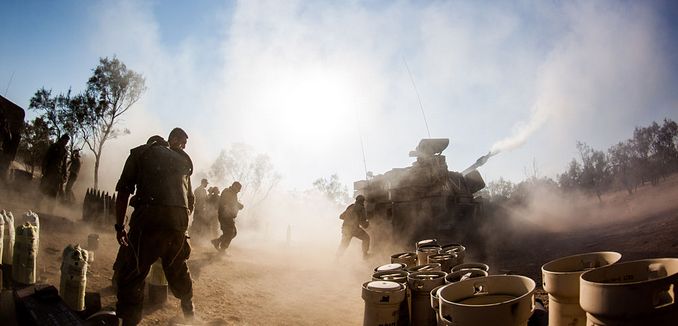In Everything You Need to Know about International Law and the Gaza War, published in the September 2014 issue of The Tower Magazine, David Daoud systematically outlined the laws of war and their relevance to Israel’s Operation Protective Edge.
Daoud began his analysis by acknowledging that “when a respected jurist like Navi Pillay, the U.N. High Commissioner for Human Rights, calls Israel’s military campaign ‘disproportionate,’ claims the IDF’s ‘disregard for international humanitarian law and for the right to life was shockingly evident’ in many of its attacks, and says that Israel is insufficiently protecting Gaza’s civilians ‘in a manner that could amount to war crimes,’ the accusations cannot be so easily dismissed.” However, by explaining the principles that guide lawful warfare, Daoud exposed Pillay’s pronouncement as malicious rhetoric, and not as a considered legal opinion.
Daoud explained that there are two questions that must be answered to determine whether or not a state committed war crimes. They are “jus ad bellum, which governs the right of a state to use armed force in self-defense, and jus in bello, which determines the legality of actions taken in a war.” Regarding Israel’s right to self-defense, Daoud explains:
Israel was provoked into launching Protective Edge by continued rocket and mortar fire from Gaza into southern Israel, for which Hamas, as the ruling government in Gaza, is ultimately responsible. Protective Edge grew out of the prior Operation Brother’s Keeper, launched in the West Bank after Hamas operatives from Hebron kidnapped three Israeli teenagers. Hamas denied responsibility (though eventually admitted it), and refused to return the teens. Instead, between July 2 and 7, it launched 230 rockets into Israel. The cycle of escalation led to the launching of Protective Edge on July 8. Additionally, for some time Israel possessed intelligence that Hamas had built a large offensive tunnel network leading into Israel, discovering three of them in 2013.
Once Israel was involved in armed conflict with Hamas, concepts such as “military necessity,” “proportionality,” and “distinction” came into play. Military necessity is an ongoing judgment “whether defensive armed force is necessary to halt and repel an armed attack, or whether peaceful alternatives exist.” Once necessity has been established, proportionality “determines the breadth of that permissible force.” After the necessity and intensity of force have been determined, distinction guides what may be targeted. Daoud explains, “basically, a house is a house, a school is a school, and a mosque is a mosque—and therefore immune from attack—unless it is known to be a used for a military purpose. Then it becomes a lawful military target.”
While much of the reporting of and commentary about Operation Protective Edge has focused on the number of civilian casualties, civilian casualties alone say nothing about whether a state and its military have committed war crimes as a matter of policy or in violation of its standards. What is interesting, Daoud notes, is that in Israel’s various conflicts against terrorist organizations such as Hamas or Hezbollah, which are known to hide among civilians, the proportion of civilian to combatant casualties is much lower than the norm in modern conflicts, which the Red Cross estimated to be ten civilians for every combatant:
During the Second Lebanon War in 2006, Amnesty International and the Lebanese government estimate that a total of 1,191 civilians and combatants were killed. Human Rights Watch put the number at 1,109. The IDF estimates that 600 to 800 of those were Hezbollah fighters; the UN’s official estimate is 500 fighters. Even according to the worst estimates, that’s a ratio of approximately 1:1. Considering the fact that Hezbollah fully embedded its military structure into the civilian population, such a low ratio can only attest to the considerable efforts the IDF took to spare Lebanese civilians from the effects of the war.
In Operation Cast Lead of 2008-2009, the final IDF report—corroborated by Hamas, no less—identified a total of 709 combatants killed out of a total of 1,161 Gaza fatalities; 295 were positively identified as civilians and 162 men killed could not be verified. That puts the casualty ratio at 1:3. That ratio was a result of Israel’s huge investment in special weapons systems like smart bombs, intended to minimize collateral damage to civilians. In fact, 81 percent of the 5,000 missiles the IDF dropped in Operation Cast Lead were smart bombs, an unprecedented percentage in modern warfare. The IDF also stepped up its efforts to warn civilians to flee targeted areas, and diverted missiles at the last moment if civilians entered a planned strike zone. It is true that the Goldstone Report claimed Israel targeted civilians as a policy and a strategy, but even Justice Richard Goldstone himself recanted this baseless assertion.
The casualty ratios for Operation Protective Edge are not yet known. The Meir Amit Intelligence and Terrorism Information Center has been conducting an ongoing assessment and for those casualties who are known with any certainty, the ratio currently (.pdf) is 49% combatants to 51% non-combatants.
While Israeli policies and past conflicts certainly give the unbiased observer reason to assume that Israel did not commit war crimes, “some incidents do raise questions that the IDF must answer.” Israel is reported to be investigating five incidents for violations during Operation Protective Edge.
Towards the end of his essay, Daoud writes that “sympathy for the plight of the Palestinians must not lead to the distortion of a noble legal system in order to judge the innocent guilty simply because this would create a desired political outcome.” He also cautions that allowing Israel’s enemies and critics to determine what is and what isn’t lawful warfare threatens to make the laws of war “a meaningless tool of power, another form of tyranny.”
[Photo: Israel Defense Forces / WikiCommons ]




